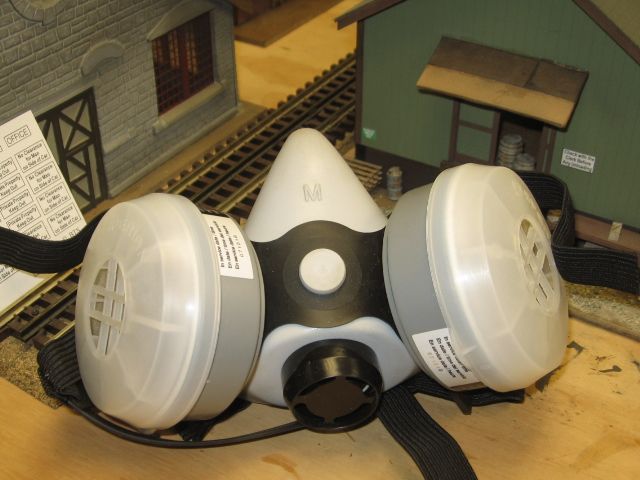I posted this thread May this year. Please be careful with all materials used as part of Model Railroading.  Mike CT
Mike CT 
Safety meeting for the day. I had posted this a few years ago, part of an airbrush tread. The material used for painting and paint removal need safety precautions. All would have an associated MSDS. Material Safety Data Sheet. Surprisingly Water clean-up acrylic paints, cleaners, and thinners can be issues. I eventually purchased an organic cartridge respirator. Eye protection is also a good thing. Noted that I usually felt better at the end of the day.
This was added as part of the safety discussion.
quote:
Originally posted by OntarioRailFan: I've got a good paint booth vented directly outside. I also use ONLY water based paint. Though I have not used a respirator. Is this something I should add before I start my next round of painting????
YES From my shelf, what is written on the bottles.
Badger Modelflex acrylic paint Non-toxic. Keep out of the reach of children. If ingested do not induce vomiting. Call a physician immediately.
Polyscale acrylic model RR paint Non-toxic. Contains Isobutanol and DPNB. Causes eye irritation. Avoid eye contact. First Aid: For eye contact flush immediately with plenty of water. Not intended for use by children
Polyscale acrylic thinner No caution listed.
Polyscale acrylic cleaner May irritate eyes Do not get in eyes. Do not take internally. Close container after each use. Keep out of reach of children. First aid treatment : Contains gylcol ethers. If swallowed call a physician or poison control center immediately. In case of eye contact, flush with plenty of water.
Weaver ScalecoatI Paint Danger Flammable Harmful or fatal if swallowed vapor harmful Read addional caution on back of label. Contains Zylene, Benzene, Butanone Oxime, and Petroleum Distillates that may be harmful if misused. Read caution on individual containers carefully. Harmful or fatal if swallowed. If swallowed do not induce vomiting. Call Physician immediately. Vapor harmful, May be harmful by breathing vapor. Use proper ventilation. When using,do not eat, drink, or smoke. Wash hands immediately after use. Avoid skin contact. Keep container tightly closed when not in use. Do not use on interior surfaces. For use on model train cars and hobby related models only. FIRST AID: In case of eye contact thoroughly flush with water for 15 minutes and get medical attention. For skin contact wash thoroughly with soap and water. In case of respiratory difficulty, provide fresh air and call physician. Call 1 800 424 9300 for more health information FLAMABLE: Keep away from heat, sparks, and open flame. WARNING This product contains chemicals known to the State of Californina to cause cancer and birth defects or other reproductive harm. KEEP OUT OF THE REACH OF CHILDREN. (Ya, that's all on that one ounce bottle of paint).
Floquil Railroad Colors For Emergency Health Information call 1 800 962 1253. Contains petroleum distillates. Vapor Harmful Keep away from heat, sparks and open flame. Causes eye and skin irritation. To avoid breathin vapors and spray mist, open windows and doors to ensure fresh aire entry during application and drying. If you experience eye watering, headaches, or dizziness, increase fresh air or wear respiratory protection. Close container after each use. Avoid contact with eyes and skin. USE WITH ADEQUATE VENTILATION. WARNING this product contains chemicals know to the State of California to cause cancer and birth defects or other reproductive harm. FIRST AID: If swallowed. Do not induce vomiting. Call physcian immediately. KEEP OUT OF REACH OF CHILDREN.
Floquil air brush thinner CONTENTS AND FUMES MAY CATCH FIRE. CONTENTS HARMFUL. MAY IRRITATE EYES AND SKIN. KEEP OUT OF REACH OF CHILDREN. Vapors may ignite explosively. vapors harmful. May affect the brain and nervous system. causing dizziness, headache, or nausea. Causes eye, skin, nose, and throat irritation. Keep away from heat and flame. Avoid eye contact. Avoid breathing vapors and spray mist. Use only in well-ventilated area. Wash thoroughly after handling. Intentional misuse by deliberate concentrating and inhaling the contents may be harmful or fatal. FIRST AID: Contains petroleum distillates and n-propoxypropanol. In case of eye contact, flush with plenty of water for 15 minutes. If swallowd call physician ofr Poison Control Center immediately. If inhaled, seek fresh air. If on skin, rinse well with water. There are a lot of other chemicals on the shelf. All with some kind of a caution. IMO At the bare minimum even using acrylic, water clean up, paints adequate ventalition should be provided. This was part of a larger discussion at the time that moved toward full face protection,(eyes),and a filtering system that pulls or inhibits breathing any of the chemicals present. There has also been several threads on model spray paint booths. Spray Booth currently on the 2 Rail Forum. Mike
Respirator from a local auto parts or body shop paint supply. Note that the two cartridges are designed to be replaced periodically. $30 to $50 maybe ????


















